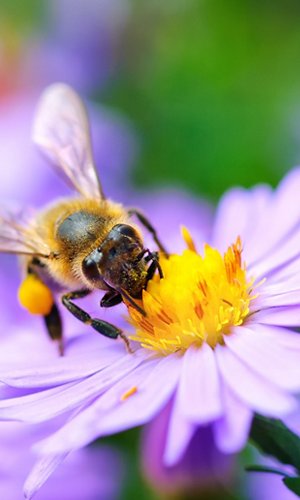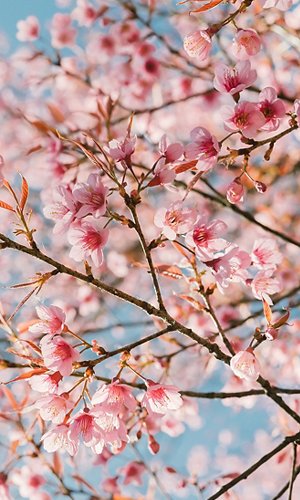Firmly rooted in soil, over the course of their evolution plants have had to develop biological mechanisms for feeding and reproduction without moving, a characteristic that differentiates them from animals which on the contrary move around to procure food and to mate. While they are able to feed themselves independently by means of photosynthesis, in the case of reproduction, many plants need a go-between to transfer pollen for them, that is they need to be pollinated. Pollination is the process of transfer of pollen from the anthers, or male part of the flower, to the stigma, that is the female part, and it is a key passage that permits fecundation, production of seeds and, therefore, reproduction of plants.
Voice search

Pollination, a perfect alliance between plants and animals
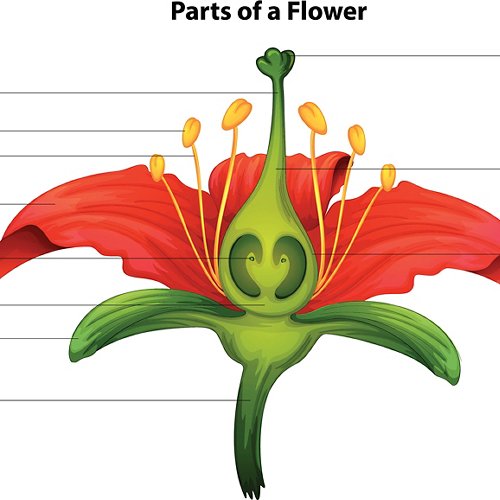
In most plants, pollination takes place between different individuals (cross-pollination) and only in some plants is pollen transferred onto the same flower or onto flowers of the same plant (self-pollination). Due to self-pollination, plants can reproduce even in environments where there are few or no pollinators, like the Arctic or at high altitudes, or when they are isolated from other specimens of the same species. Some plants are able to use both types of pollination, but often they have developed mechanisms that favour cross-pollination, because exchange of pollen between different organisms guarantees maintenance of genetic variety and, as a result, healthier plants that are more resistant to disease.
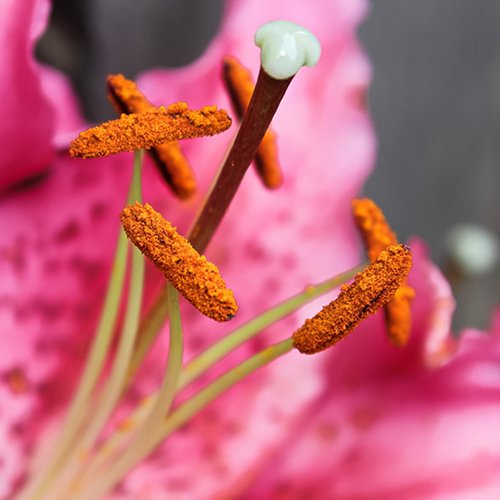
Stamen and stigma of a lily flower. Pollen can be seen on the anthers.
But how does a grain of pollen reach the egg cell of another plant? It can do so only if transported by pollinating agents: animals (insects, birds or bats), wind or water. In the course of evolution, therefore, both plants and animals have developed specific characteristics that make them both increasingly more specialised and ‘in tune’ with each other to ensure cross-fertilisation between different plants.
When wind and water are pollinators
Anemophily (or anemogamy), that is pollination by wind, is the simplest and, perhaps, the most primitive form of pollen transport. At our latitudes during spring, early summer or the end of autumn, the anthers of many flowers open and release small grains of pollen into the air, and these are transported by the wind. Since the wind cannot guarantee that the pollen will always arrive at its destination, anemophilous species produce high amounts of pollen to ensure successful pollination. This is the reason for all the yellowish dust and white fluff that trouble allergy sufferers making their eyes red and irritating their noses and throats. Poplar, beech, alder, oak, chestnut, willow and elm trees, wheat, maize, oats, rice and nettle are examples of anemophilous plants because their pollen is transported by the wind. Since they do not have to attract animals for pollination, their flowers do not contain nectar and are neither showy nor highly scented, on the contrary, they are small, not very noticeable, and are often grouped together in inflorescences so as to guarantee a high production of pollen.
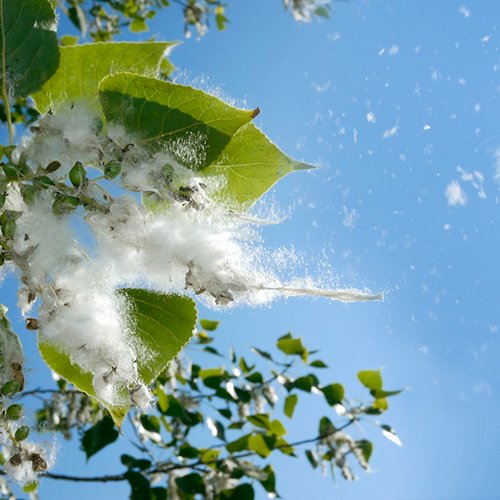
Anemophilous pollination of the poplar
Hydrophily (or hydrogamy), that is pollination by water, is a method of pollen transport that is not very common and is limited to some aquatic plants. For example, posidonia oceanica, a seagrass species, releases pollen into the sea in the form of gelatinous filaments.
When animals pollinate flowers: winning associations
When the pollinator is an animal – insects, mammals, birds – it is called zoophily or zoogamy. Flowering plants and pollinator animals, in fact, are an interesting example of what is known as co-evolution, that is the process whereby two distinct species of the same community influence each other’s evolution. Flowers are pollinated prevalently by insects, which obtain the nectar produced by the flowers as a reward; the insect-flower association is often species-specific, that is the flower of a plant species can be pollinated only by a certain species of insect, and an insect species visits only certain plant species. To make this possible, during evolution, the plants have developed characteristics suitable to attract specific pollinators and, in parallel, the pollinators have developed parts of their bodies and behaviour that favour pollination of specific plants. Let’s look at some examples.
Many flowers pollinated by bees have parts that reflect ultraviolet (UV) light and others that absorb it. These differences are invisible to the human eye, but easily perceived by bees, able to see the ultraviolet light spectrum. The contrast of the ultraviolet patterns with the remaining colouring of the flower is an ingenious adaptation that helps bees to immediately detect the centre of the flower where pollen can be found.
When pollinators alight on the flowers to collect or eat the pollen or to collect the abundant nectar produced by many flowers (precisely to attract pollinators), the pollen attaches to their bodies and is transported from flower to flower, thus allowing fertilisation of the plants.

A bee covered in pollen
Some flowers give off special scents to attract pollinators. The scents of these flowers derive from highly volatile essential oils, the smell of which can be perceived even a kilometre away. In this case too, there are specific pollinators able to distinguish between the many scents the one coming from ‘their’ flowers.
When dusk comes, daytime pollinators are replaced by nocturnal ones, thus giving way to bats, large moths, small marsupials or rodents. Flowers that remain open at night are generally rather large, white or in any case not very highly coloured, they issue a strong scent and are full of liquid nectar. Few people are aware of the essential role that bats play in pollination, especially in Africa and Asia. It is estimated that each year the pollination of over 500 different tropical plants and over 300 types of fruit depends on bats, attracted by the sweet nectar offered by these plants.
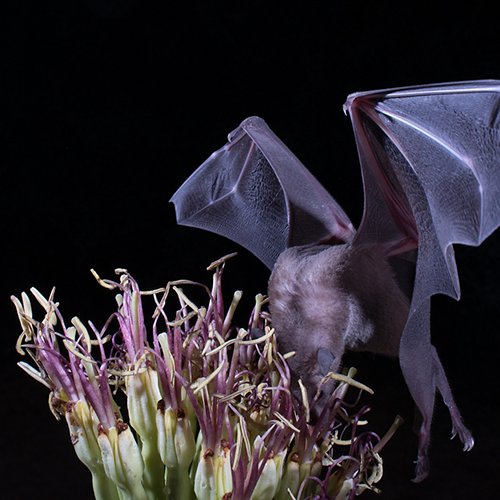
Bat that sucks the nectar of a flower
The role of birds in pollination is particularly important in Africa, the Americas and Australasia where, for example, humming birds and sunbirds are the main pollinators of wide number of plants. The flowers of plants pollinated by birds have evolved specific characteristics: generally they are brightly coloured, and they have a long tubular structure the bottom of which contains nectar, while the stamen and stigma are oriented to ensure contact with pollinators. The shape of the flower is designed so that the grains of pollen remains unavoidably attached to the head or back of the bird arriving to collect the nectar, to ensure that they will be transferred to another flower, fertilising it.

Hummingbird that feeds on the nectar of a flower
The inescapable connection of this alliance lies in the fact that neither the plants nor the populations of pollinators can exist isolated from each other: if one dies out, the other would be destined to the same fate within a very short time.
What can we do to help pollinating insects?
The European Commission suggests that local administrators should take care of public places to make them hospitable to insects. Parks and gardens can become a temporary home for pollinators, a flyway that allows insects to cross a city to reach the countryside. What about us? In everyday life? What can we do? Well of course, for a start, we can avoid killing them! The US National Academy of Sciences has compiled a list of eight good deeds that each of us can follow to help insects.
- Restoring some natural vegetation in the gardens of houses, schools and libraries. Where there is already some greenery, we should also let wild plants grow.
- Growing typical local plants. Insects prefer familiar flowers to ornamental ones that come from far away.
- Spraying less insecticides.
- Reducing outdoor lighting. Lamps attract and often kill nocturnal insects, such as moths.
- Avoiding washing cars in gardens. Soap is harmful.
- Reading, looking at photos, watching documentaries. Let’s learn about insects and learn to appreciate them.
- Teaching children not to be afraid of them.
- Supporting environmental policies.
In short, we should welcome insects because they are important not only for the economy but also because they have an aesthetic and cultural value. They are part of the history of an area, they have contributed to building it, to increasing its value.
by Benedetta Palazzo

